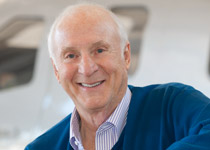Proficient Pilot: Blind flying
An unusual student offers the instructor lessons, too
Despite his lifelong disability—or perhaps because of it—Sullivan learned to attack life with a zest and determination rarely found in sighted people. He not only attended Harvard University but also graduated with his name on the Dean’s Honor List. Inclined toward sports as well as academia, Sullivan competed against sighted students to become an amateur U.S. National Wrestling Champion. He also earned accolades as a professional singer, composer, and author.
Perhaps most remarkable is that Sullivan made 37 parachute jumps, of which many were free falls. As far as I am concerned, a voluntary leap from an airworthy airplane requires more resolution than I would care to muster. “Sighted people,” he says, “are frightened by what they see. I obviously have no such hang-up.”
Sullivan did pose a unique problem for instructors at the jump school. After all, how could a blind jumper steer toward the drop zone and judge his height above the ground in preparation for landing? The solution was simple yet effective. A small, portable VHF receiver was installed in Sullivan’s helmet, and an observer on the ground would transmit instructions. The system worked well until Sullivan’s thirty-seventh and final jump. Shortly after bailing out and savoring the ecstasy of free fall, Sullivan noticed that his earphones were unusually quiet—no static, no instructions, nada. The radio had failed! He quickly located and tugged at the D-ring attached to his ripcord. Seconds later his body jerked convulsively in response to the blossoming chute.
As he dangled helplessly and drifted in lonely darkness, Sullivan could feel the tightening grip of terror. He had no idea when or what or how he would hit. The agonizing seconds passed slowly, and Sullivan could only imagine the terrible fate rushing to meet him. Miraculously, Sullivan landed in a tree that broke his fall and enabled him to escape serious injury. Although this incident dampened his enthusiasm for skydiving and taught him not to tempt the fates so daringly, he continued with tamer sports such as golf, horseback riding, and jogging.
Given his penchant for new experiences, I was not surprised when he asked if I would arrange for him to try his hand at flying—literally. So it was that I found myself guiding Sullivan through a walk-around inspection of a Piper Cherokee Six. I had him feel and move the control surfaces, teaching him something of what he would be doing when moving the flight controls in flight. His grasp of these fundamentals was surprisingly astute, perhaps because of his childhood familiarity with model airplanes.
Following my instructions, Sullivan started the engine and called ground control for a clearance. His first and simplest task would be taxiing. Using only the commands “right, left, more power, less power, straight ahead, and slow down,” I could guide him toward the runup area.
I soon talked Sullivan onto the runway, had him advance the throttle, and advised him to soften rudder-pedal usage as we accelerated. Following my suggestion, he gingerly raised the nose, and we were airborne. I cannot begin to describe the glee that spread across his face as he realized that he had caused us to break free of gravity.
During climb I obviously had to assist here and there, but all things considered, Sullivan did a fine job in response to verbal commands. In level flight he maintained altitude reasonably well and without guidance because of his keen sense of hearing. At the slightest increase in airspeed (wind noise) he would apply nose-up back-pressure and vice-versa. (Do not tell him that I had to nudge the rudder pedals now and again to keep us on an even keel.)
The landing, of course, was challenging, and there was no way for me to talk him down without a frequent helping hand, but he did his best under trying circumstances. OK. So, we landed with a bit of a thump. I have made worse landings on my own.
As we returned to the ramp, Sullivan was all smiles, obviously elated with having maneuvered an airplane even though he knew he could never do it perfectly or alone. “It’s not so important to master something,” he said, “but it’s awfully important that you try.”
“You’d make a lousy pilot,” I chided Tom. “You were so preoccupied with flying the airplane that you never once looked out the window for traffic.”
He burst into laughter and promised not to make the same mistake again.

